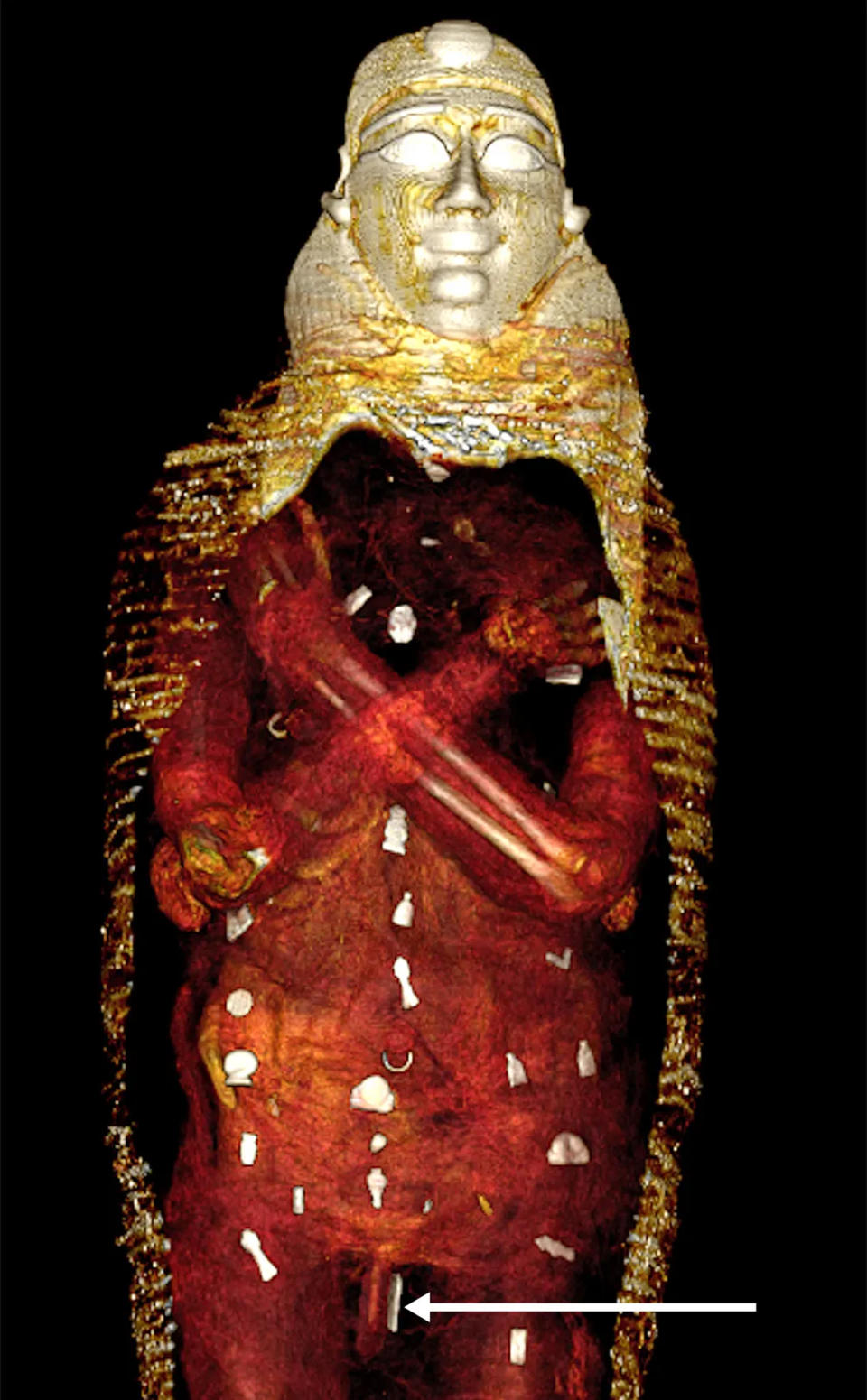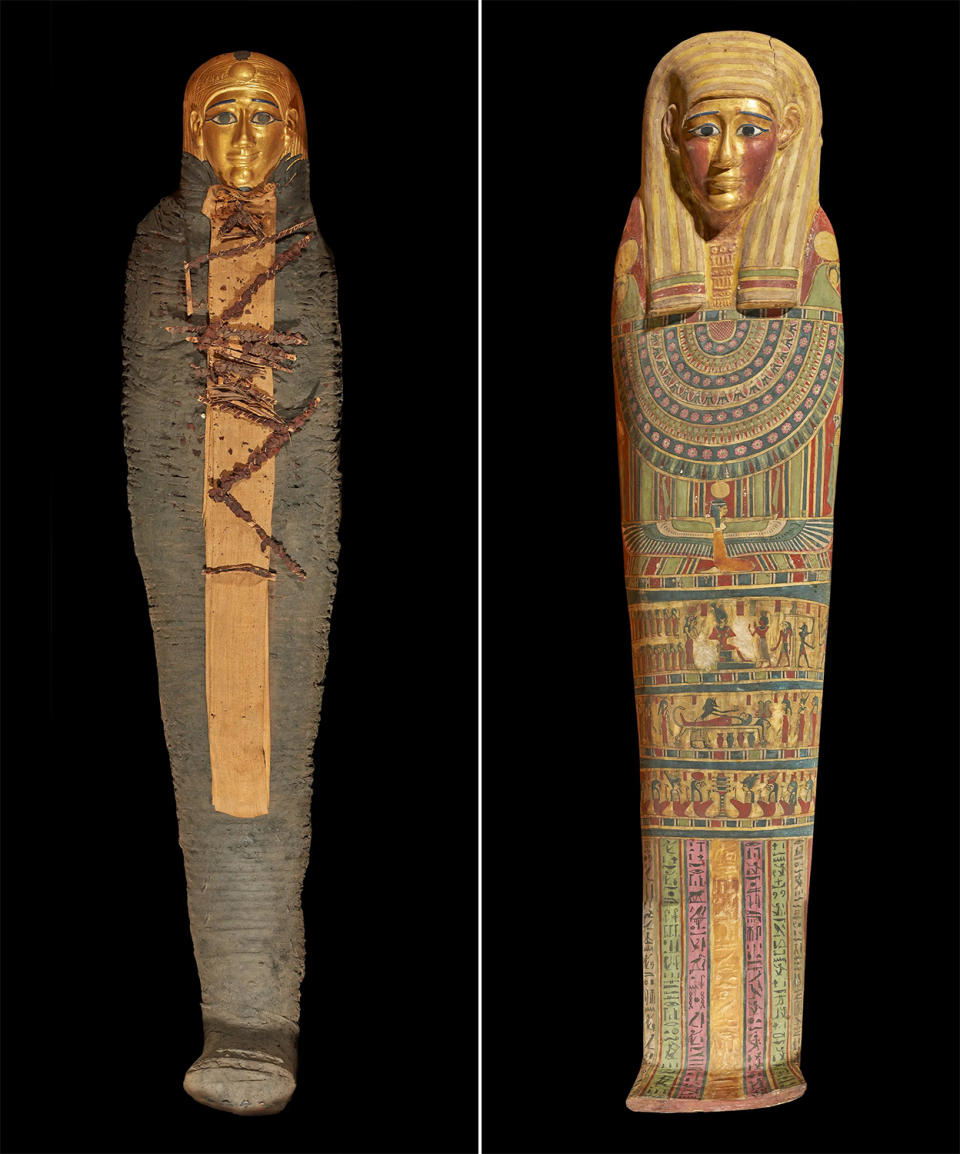Scans reveal secrets of Egypt's mummified 'golden boy'
CAIRO — Known as Egypt’s “golden boy,” the mummified remains of a teenager buried 2,300 years ago have long remained shrouded in mystery. Now they have been “digitally unwrapped” by scientists, revealing intimate details that went undiscovered for over a century.
Radiologists at Cairo University in Egypt used CT scans to non-invasively unwrap the remains, uncovering signs of wealth as well as efforts to ensure his safe passage to the afterlife.
According to the authors of a study published Tuesday about the discoveries, 49 precious amulets adorned the remains, including a golden heart scarab that was used to replace the boy’s heart.
Egyptian embalmers placed amulets to protect and provide vitality for the body in the afterlife, and a gold tongue amulet was placed inside the mouth to ensure the deceased could speak in the afterlife.

Sahar Saleem, a professor of radiology at the faculty of medicine at Cairo University and a co-author of the study, told NBC News the undisturbed remains were revealing for both the socioeconomic status of the boy — likely to have come from a wealthy family — and the significance of amulets in the afterlife, which was a central focus of ancient Egyptians’ complex belief system.
The body had undergone a “very expensive and meticulous modification process,” said Saleem, who has been digitally unwrapping mummies for years, including those of Pharaonic royals. “I would say that he came from some very rich family or maybe a noble family.”
Saleem wrote in the study that “the heart scarab is mentioned in chapter 30 of the Book of the Dead: It was important in the afterlife during judging the deceased and weighing the heart against the feather of the goddess Maat.”
The mummified remains were discovered in 1916 at a cemetery in Nag el-Hassay in southern Egypt that was used from around 332 to 30 B.C., in what’s known as the Ptolemaic period. It was stored unexamined in the basement of the Egyptian Museum in Cairo until the new study.
Experts were able to determine that the boy was 14 or 15 years old, using the degree of bone fusion and the non-erupted wisdom teeth. He was 4 foot 2 (128 centimeters) and uncircumcised, and a cause of death could not be determined, the study said.
The boy’s remains were laid inside two coffins, an outer with a Greek inscription in black, and an inner wooden sarcophagus.
As well as being buried with a gilded mask, the teenager was buried with a pair of sandals as well.
“The sandals were probably meant to enable the boy to walk out of the coffin,” Saleem wrote. “According to the ancient Egyptians’ ritual Book of The Dead, the deceased had to wear white sandals to be pious and clean before reciting its verses.”

Joann Fletcher, an Egyptologist and a professor at the University of York who was not involved with the study, told NBC News it demonstrated the value of “non-invasive, non-destructive forms of analysis.”
“CT imaging for the purposes of 3D printing can produce genuine advances in the field of mummy studies — we ourselves used this same pioneering technology back in 2020 to produce the authentic vocal sound of an ancient Egyptian for the very first time,” she said.
Amulets were both placed inside the “golden boy” and between the wrappings used to mummify the remains, the study published Tuesday found. The scan revealed they were arranged in three columns.
“It is good to see such scanning techniques used to examine the way these characteristic amulets were placed at specific points on the body where they served a protective purpose,” Fletcher said.
Many of the amulets were metal, likely gold, and the other amulets were made of faience, stones or fired clay, the study revealed.
“All too often in the past, they’ve been removed from their original context on the body, and are therefore seen as little more than pieces of jewelry which is to misunderstand their actual purpose as a potent amulet,” Fletcher added.
The new study comes as museums in the U.K. reckon with whether the term "mummy" is appropriate to describe mummified remains, because of what some say are its “dehumanizing” connotations.
“Where we know the name of an individual we use that, otherwise we use the term ‘mummified man, woman, boy, girl or person’ on our labels, because we are referring to people, not objects,” a spokesperson for National Museums Scotland said in an email.
“The word ‘mummy’ is not incorrect, but it is dehumanizing, whereas using the term ‘mummified person’ encourages our visitors to think of the individual.”
Charlene Gubash reported from Cairo and Aina J. Khan from London.
This article was originally published on NBCNews.com

